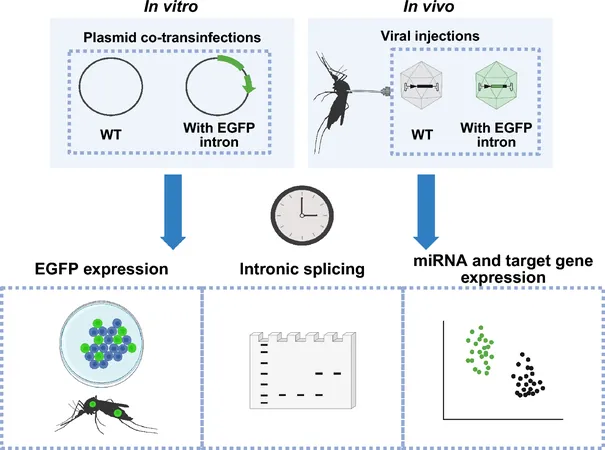
Unlocking the Secrets of Mosquito Genetics: A Breakthrough in Malaria Research!
2025-08-19
Author: Wei Ling
The Malaria Crisis and the Role of Anopheles Mosquitoes
Anopheles gambiae has emerged as the primary culprit in the spread of malaria, particularly in Sub-Saharan Africa, where the disease continues to wreak havoc. Traditional methods to combat malaria, such as insecticide-treated bed nets and chemical sprays, are faltering in the face of rising insecticide resistance. With a parallel increase in drug-resistant malaria parasites, there's an urgent need for groundbreaking innovations in mosquito biology and malaria control.
The Need for New Solutions
While CRISPR-Cas9 is a powerful genetic tool, it comes with limitations—requiring specialized equipment and extensive time to modify the mosquito genome. Researchers are exploring alternatives like using genetically modified microbes to introduce genetic material without altering the mosquito DNA itself. This approach could one day enable scientists to create malaria-resistant mosquitoes or control mosquito populations without triggering further resistance.
Potential of Anopheles gambiae Densovirus (AgDNV)
Enter Anopheles gambiae densovirus (AgDNV), a microbe discovered in 2008 that shows great promise in mosquito genetic studies. This non-pathogenic virus specifically infects An. gambiae while exhibiting minimal effects on the mosquito's fitness. As researchers focus on AgDNV, they believe it could serve as a viral vector to express genes that help combat the malaria parasite itself.
A Groundbreaking Approach to Gene Expression
A revolutionary co-plasmid expression system has been developed to harness AgDNV’s capabilities. This system includes plasmids that incorporate essential promoter sequences and fluorescent markers, allowing scientists to visualize gene expression in crucial mosquito tissues associated with immunity and disease transmission.
MicroRNA: The New Frontier in Gene Regulation
MicroRNAs (miRNAs), small RNA molecules that regulate gene expression, are being eyed as powerful tools for controlling mosquito biology. With over 160 miRNAs identified in An. gambiae, these tiny molecules could potentially be manipulated to enhance immunity, influence reproduction, or even reduce malaria transmission. Researchers are now equipped to explore the effects of specific miRNAs in mosquito cells using this innovative system.
Claiming Success: Testing miRNA Expression
In an exciting phase of research, selected miRNAs like miR8, miR34, miR305, and miR375 have been strategically chosen for expression, each known to contribute to mosquito functions such as immunity and reproduction. Preliminary results have shown promising patterns of expression and interaction with target genes.
A Bright Future for Malaria Control Efforts
This pioneering intron delivery system opens up new avenues for research on small RNAs, anticipating a future where we can manipulate mosquito genomics to reduce disease transmission. As scientists continue to unravel the complexities of mosquito biology, the dream of creating a malaria-free world edges closer to reality.


 Brasil (PT)
Brasil (PT)
 Canada (EN)
Canada (EN)
 Chile (ES)
Chile (ES)
 Česko (CS)
Česko (CS)
 대한민국 (KO)
대한민국 (KO)
 España (ES)
España (ES)
 France (FR)
France (FR)
 Hong Kong (EN)
Hong Kong (EN)
 Italia (IT)
Italia (IT)
 日本 (JA)
日本 (JA)
 Magyarország (HU)
Magyarország (HU)
 Norge (NO)
Norge (NO)
 Polska (PL)
Polska (PL)
 Schweiz (DE)
Schweiz (DE)
 Singapore (EN)
Singapore (EN)
 Sverige (SV)
Sverige (SV)
 Suomi (FI)
Suomi (FI)
 Türkiye (TR)
Türkiye (TR)
 الإمارات العربية المتحدة (AR)
الإمارات العربية المتحدة (AR)